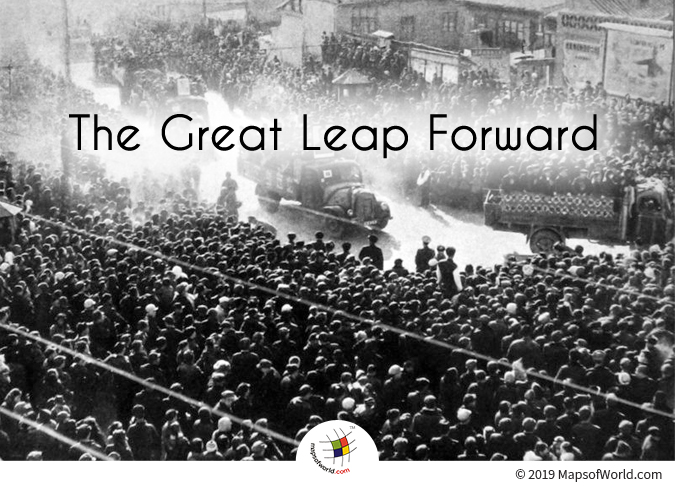

The Great Leap Forward - An Economic and Social Campaign by the Communist Party of China
In Chinese history, the Great Leap Forward refers to the radical campaign of the Chinese Communist Party under Mao Zedong for the rapid economic development of the country from 1958 to the early 1960s. The campaign was aimed at organizing the country’s huge population into large-scale rural farming cooperatives (or communes) and small manufacturing units, in order to attain almost unrealistic agricultural and industrial goals.
The seeds of the Great Leap Forward were sown resulting from the fact that the Soviet model of industrialization failed in China. The Soviet model advocated the investment of capital accumulated from agricultural products’ sale into heavy machinery. This was essentially inapplicable in a country like China, where there was a high density of population and lack of large agricultural surplus to invest in capital.
Mao advocated those methods of industrialization which were labor-intensive. The idea was to focus more on manpower, instead of capital expenditure and work driven through machines. Through it, the country wanted to get around the typical slow process of industrialization that involved the purchase of heavy machinery and gradual accumulation of capital.
After a thorough debate, it was decided that industry and agriculture could be developed simultaneously, if there was a change in the working habits of people, More reliance was placed on labor instead of the machine-centered industrial processes. Thus, early in 1958, an experimental farming cooperative or commune was developed in Henan’s north-central province. People had to surrender their property, farm animals and tools upon joining the commune, and were assigned duties in return. Soon, the whole idea and the commune system was promulgated across the entire country.
The Great Leap Forward was envisaged as a program to swiftly increase China’s agricultural output, as well as surpass the United States (US) and the United Kingdom (UK) in steel production. As millions of citizens were shifted into the new commune system, emphasis remained on adherence to the Maoist ideology rather than gaining technical expertise. The political and agricultural decisions and discussions were decentralized. Also, communal kitchens and childcare centers were developed on communes in order to free women for work, and peasants were grouped into separate brigade teams to carry out allocated activities.
Initially, the Soviet style farming strategies and procedures of dense cropping adopted during this period gave a bumper harvest. Thereafter, however, the yields declined, resulting in mass starvation in the countryside. Even numerous farm animals were slaughtered in the process, at the hands of discontented peasants. Similarly, the manufacturing program was implemented by overzealous cadres in such haste that often peasants were compelled to melt useful household utensils and farm implements in the backyard furnaces of their houses to produce steel.
Lack of central planning, and errors in the implementation of the program resulted in several unfavorable developments. Factors like unskilled farm labor’s diversion to small-scale industry, and the inefficiency of the communes, played a major role in the disruption of agriculture in China. Natural calamities like floods and droughts, which played out over a course of the coming three years, aggravated the crisis, and soon the situation turned into a national disaster. As per some estimates, during the years between 1959 and 1962, approximately 20 million people died due to starvation in China.
All these negative developments and the breakdown of the Chinese economy led the government to revoke the Great Leap Forward program. And by the early 1960, the whole program was repealed. The commune system was dismantled, and once again the emphasis shifted from ideology to expertise. Agricultural implements and private plots were given back to the peasants.
The Great Leap also created divisions in the political domain, with individuals and groups within the Communist Party blaming it on different government and bureaucratic elements. With the failure of Maoist ideology apparent, Mao stepped aside for some years to let other political leaders lead the economic recovery efforts.
The failed campaign continues to serve as a lesson for China to this day, which has now transformed into one of the biggest economies in the world.
Related Links:
The Republic of Madagascar is an island country located in the Indian Ocean, off the…
The Euro is the official currency of the European Union. It is, however, not incumbent…
There are many countries or regions that are partially recognized by the UN, have disputes…
The Alaska Statehood Act was signed into law by President Dwight D. Eisenhower in 1958,…
The name Persia may, however, only be used to refer to Iran in some contexts.…
Hawaii is an Island State in the US. It is one of the 50 states…